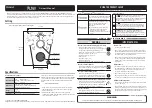
© Ultrafast Systems LLC /Vernier Software & Technology
35
this experiment, the kinetics of the back reaction will be measured for a range of temperatures in order to
determine the activation energy, E
a
, of the back reaction. The activation energy can be determined from
the slope of ln(
τ
) as a function of 1/
T
according to the Arrhenius equation:
1
where
k
is the rate constant,
τ
is the time constant of the back reaction process,
T
is the temperature in
kelvin,
A
is the pre-exponential factor in reciprocal time units, and
R
is the universal gas constant. The
literature reported value for E
a
= 62.5 kJ mol
-1
.
Procedure
Prepare the solution by taking 0.032 mg of 6-NO
2
-BIPS and dissolving it in approximately 20 mL
of toluene to give a 5.0 × 10
-6
mol L
-1
solution. The concentration was chosen such that the absorbance at
λ
= 300nm in a 1 cm cuvette of the UV absorption peak was 0.5 at room temperature (see Figure 16).
This avoids any dimerization processes as well as allows the UV irradiation to propagate through the
entire sample. If using a common UV-visible spectrometer in an undergraduate laboratory,
λ
max
should not
exceed 1.
Fill the provided cuvette with 4 ml of the 6-NO
2
-BIPS/toluene solution.
Prepare a hot bath of water that can be temperature controlled and use a thermometer to monitor
the temperature. The bottom half of the cuvette should be placed into the hot bath to allow the solution to
come into thermal equilibrium with the water. Remove the cuvette once it is in thermal equilibrium with
5 different temperatures between 30 and 60 °C (Figure 21 shows an example of measurements done at
five varying temperatures.) and place the cuvette in the Flash Photolysis Spectrometer. Set the time
window appropriately and take one measurement, returning the cuvette to the hot bath afterwards. For
multiple measurements at the same temperature, return the cuvette to the hot bath in between
measurements. This will ensure that the solution is at thermal equilibrium with the warm water for each
measurement.
An example of the generated absorbance vs. time profile is shown in Figure 22 for a temperature
of 55°C. Also shown in this plot is the fitted exponential decay function (red line) generated using Logger
Pro
software. This fit will provide the lifetime of the back reaction, which in this example is 1.33 seconds.
Once lifetimes at five different temperatures are obtained, a plot like the one in Figure 23 can be
generated. Using Logger
Pro
, a line is fit through the five data points and the slope of this line is used to
calculate the activation energy, E
a
, of the back reaction.






































